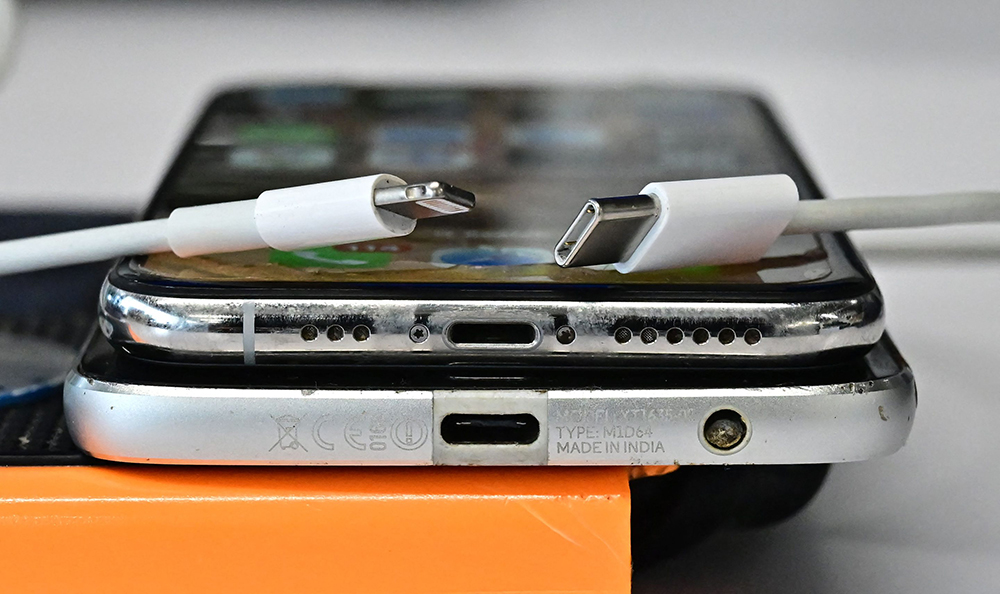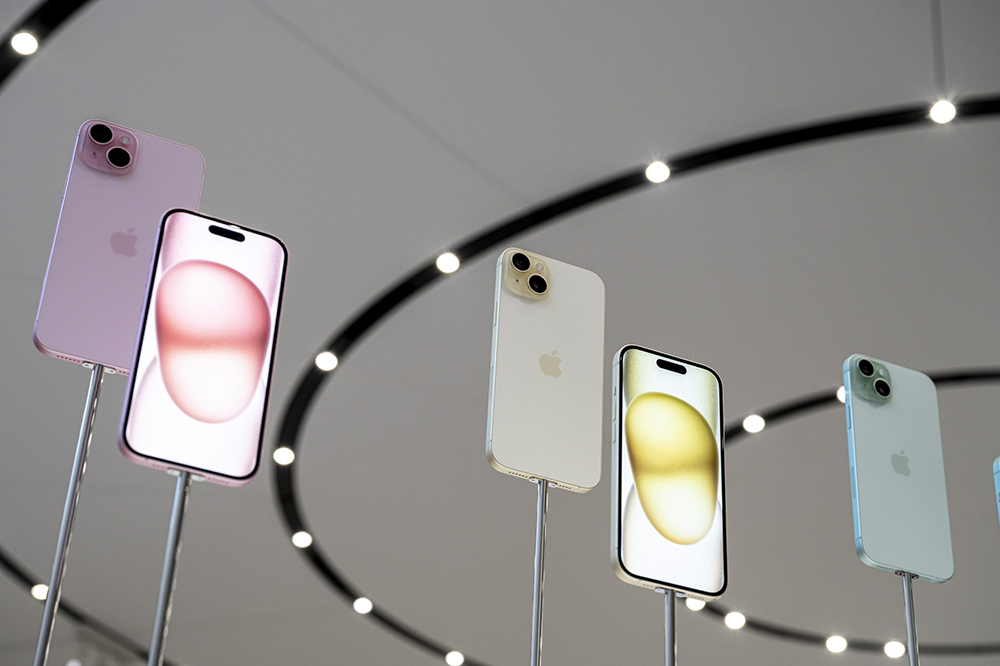iPhone 15取消Lightning充电口,准备换充电线吧

经过各种猜测之后,苹果(Apple)终于在9月12日证实,其下一代iPhone手机将与安卓(Android)手机和MacBook Pro笔记本一样,使用USB-C端口和充电线。对于需要给iPhone手机充电但在附近找不到一条苹果专有的Lightning数据线的所有人来说,这是一则好消息。从9月22日发售的iPhone 15开始,所有人可以使用同样的充电线。
但这也意味着iPhone用户需要更换家里、办公室和车里的所有Lightning数据线。由于苹果的Lightning数据线根据长度不同,售价在19美元至29美元之间,因此这是一笔不小的投资,却突然就要变得毫无价值。
这是苹果自从2007年发布初代iPhone手机以来,第二次变更其充电技术。众所周知,每当苹果的产品设计计划需要有创新时,苹果总是会毫不犹豫地放弃旧技术,凡是苹果的老客户都能够证明这一点。从软盘到光驱,苹果总是会无情地扔掉不必要的包袱,无论用户是否喜欢。
iPhone的用户上一次不得不更换数据线是在2012年,当时苹果推出了Lightning数据线接头。新接头较之前的类型是一次大幅改进,这减少了被迫更换数据线的痛苦。新接头两面可用的外形设计不分正反面,这意味着接头可以轻松插入手机,无需考虑接头的方向。
时过境迁
苹果此次更换为USB-C借口,与之前的情况不同,因为此次更换的原因主要是欧盟(EU)的法规,而不是苹果的产品计划。
欧盟的规则要求手机、平板和耳机设备统一使用USB-C充电接口,其目的是解决消费者的不满,并减少电子垃圾。欧盟将在2024年年底开始执行这些规则。
苹果的全球市场营销高级副总裁格雷格·乔斯维亚克在2022年的一次会议上承认,公司更愿意按照自己的方式行事,而不是被迫遵守监管部门的硬件决定。但他表示,尽管如此,苹果不能无视欧盟的新规。“显然我们将不得不遵守规定。”

虽然有人猜测,苹果可能彻底放弃USB-C,直接改为无线充电,但最终该公司还是遵守了欧盟的规定,并将其变成公司标准。USB-C接口除了为新iPhone手机充电外,还可以给新款MacBook和iPad充电。2022年发布的苹果传统有线耳机和AirPods Pro二代也已经升级为新接头。
采用这种通用技术,意味着苹果的客户能够在设备之间相互充电。例如,AirPods可以插到iPhone 15上进行充电。
虽然苹果决定更换充电端口,原因之一是遵守欧盟的规则,但USB-C还有另外一项优势,成为苹果的卖点之一。对于售价更高的iPhone 15 Pro和Pro Max型号,USB-C端口还支持USB-3接头。苹果称,这两款手机使用数据线传输照片、视频和其他文件的速度能够达到每秒10千兆比特,这比其他低端iPhone手机的传输速度快20倍。这更方便在iPhone与其他设备之间传输大文件。
但对于储备了大量Lightning数据线的人而言,此次调整令人喜忧参半。奇怪的是,虽然苹果在9月12日拿出大量时间夸夸其谈地介绍其环境倡议,包括在Apple Watch表带中停止使用皮革,还播放了一段有自然之母(Mother Nature)的滑稽短片,但苹果却并未提到消费者应该如何回收这些很快就要变得毫无价值的Lightning数据线。(财富中文网)
译者:刘进龙
审校:汪皓
经过各种猜测之后,苹果(Apple)终于在9月12日证实,其下一代iPhone手机将与安卓(Android)手机和MacBook Pro笔记本一样,使用USB-C端口和充电线。对于需要给iPhone手机充电但在附近找不到一条苹果专有的Lightning数据线的所有人来说,这是一则好消息。从9月22日发售的iPhone 15开始,所有人可以使用同样的充电线。
但这也意味着iPhone用户需要更换家里、办公室和车里的所有Lightning数据线。由于苹果的Lightning数据线根据长度不同,售价在19美元至29美元之间,因此这是一笔不小的投资,却突然就要变得毫无价值。
这是苹果自从2007年发布初代iPhone手机以来,第二次变更其充电技术。众所周知,每当苹果的产品设计计划需要有创新时,苹果总是会毫不犹豫地放弃旧技术,凡是苹果的老客户都能够证明这一点。从软盘到光驱,苹果总是会无情地扔掉不必要的包袱,无论用户是否喜欢。
iPhone的用户上一次不得不更换数据线是在2012年,当时苹果推出了Lightning数据线接头。新接头较之前的类型是一次大幅改进,这减少了被迫更换数据线的痛苦。新接头两面可用的外形设计不分正反面,这意味着接头可以轻松插入手机,无需考虑接头的方向。
时过境迁
苹果此次更换为USB-C借口,与之前的情况不同,因为此次更换的原因主要是欧盟(EU)的法规,而不是苹果的产品计划。
欧盟的规则要求手机、平板和耳机设备统一使用USB-C充电接口,其目的是解决消费者的不满,并减少电子垃圾。欧盟将在2024年年底开始执行这些规则。
苹果的全球市场营销高级副总裁格雷格·乔斯维亚克在2022年的一次会议上承认,公司更愿意按照自己的方式行事,而不是被迫遵守监管部门的硬件决定。但他表示,尽管如此,苹果不能无视欧盟的新规。“显然我们将不得不遵守规定。”
虽然有人猜测,苹果可能彻底放弃USB-C,直接改为无线充电,但最终该公司还是遵守了欧盟的规定,并将其变成公司标准。USB-C接口除了为新iPhone手机充电外,还可以给新款MacBook和iPad充电。2022年发布的苹果传统有线耳机和AirPods Pro二代也已经升级为新接头。
采用这种通用技术,意味着苹果的客户能够在设备之间相互充电。例如,AirPods可以插到iPhone 15上进行充电。
虽然苹果决定更换充电端口,原因之一是遵守欧盟的规则,但USB-C还有另外一项优势,成为苹果的卖点之一。对于售价更高的iPhone 15 Pro和Pro Max型号,USB-C端口还支持USB-3接头。苹果称,这两款手机使用数据线传输照片、视频和其他文件的速度能够达到每秒10千兆比特,这比其他低端iPhone手机的传输速度快20倍。这更方便在iPhone与其他设备之间传输大文件。
但对于储备了大量Lightning数据线的人而言,此次调整令人喜忧参半。奇怪的是,虽然苹果在9月12日拿出大量时间夸夸其谈地介绍其环境倡议,包括在Apple Watch表带中停止使用皮革,还播放了一段有自然之母(Mother Nature)的滑稽短片,但苹果却并未提到消费者应该如何回收这些很快就要变得毫无价值的Lightning数据线。(财富中文网)
译者:刘进龙
审校:汪皓
After much speculation, Apple confirmed on September 12 that its next iPhone will charge using a USB-C port and cable—the same type of connector used by Android phones and MacBook Pros. That’s welcome news for everyone who’s ever needed to recharge their iPhone but couldn’t find anyone nearby with one of Apple’s proprietary Lightning connector cables. Starting with the iPhone 15, which will be available Sept 22, everyone will have the same connectors.
But it also means that iPhone owners will need to replace all those Lightning connector cables in their homes, offices, and cars. Given that Apple sells Lightning cables for between $19 and $29, depending on length, that’s a not inconsiderable investment that will suddenly become worthless.
The change marks the second time Apple has changed the iPhone’s charging technology since it launched the original iPhone in 2007. And as any longtime Apple customer can attest, the company is famously unsentimental about abandoning old technology when its product design plans call for something new. From floppy disks to optical drives, Apple has a history of ruthlessly eliminating unwanted baggage, whether users like it or not.
The last time iPhone owners had to repurchase all their cables was in 2012, when Apple introduced the Lightning connector. The sting of the forced switch was lessened by the fact that the connector was a big improvement over its predecessor—its ambidextrous shape meant it could be plugged into a phone regardless of orientation; there was no up or down side.
This time it’s different
Apple’s move to USB-C is different from previous changes in that it appears to be driven by EU regulations rather than Apple’s product plans.
The rules were intended to address consumer frustrations and reduce electronic waste, by requiring that mobile phones, tablets and headphones have one common charger, USB-C. The EU will begin enforcing the rules at the end of 2024.
Greg Joswiak, Apple’s senior vice president of worldwide marketing, acknowledged at a conference last year that the company prefers to go its own way rather than being forced to follow hardware decisions made by regulators. That said, Apple could not ignore the rule, he noted. “Obviously we’ll have to comply.”
While there had been speculation that Apple might opt to skip USB-C altogether and move straight to wireless charging, the company ultimately complied with the EU rules and made it the company-wide standard. In addition to charging the new iPhone, the USB-C will be able to power newer MacBooks and iPads. Apple’s traditional wired headphones and the AirPods Pro 2nd Generation, which launched in 2022, have also been updated with the new connector.
The shared technology means Apple customers will be able to charge their devices by plugging them into each other. For example, AirPods can recharge by being plugged into the iPhone 15.
While compliance with EU rules may be a factor in the company’s decision to switch charging ports, the USB-C offers another advantage that Apple is selling to its customers. For the iPhone 15 Pro and Pro Max models, the more expensive of the roster, the port also supports a USB-3 connector. Using that cable, the phones can transfer photos, videos and other files at 10 gigabits per second, which is 20-times faster than transfer speeds on lower-grade iPhones, Apple said. The offering makes it easier to move large files to and from an iPhone.
Still for those with a large stockpile of Lightning port cables it’s a bittersweet change. And oddly, while Apple spent a good deal of time bragging about its environmental initiatives on September 12, including its decision to stop using leather in its Apple Watch bands and a goofy skit involving Mother Nature, it never once mentioned how consumers can recycle all those soon-to-be-worthless Lightning cables.













